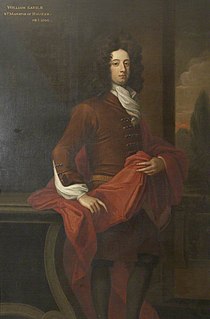This article needs additional citations for verification .(March 2013) (Learn how and when to remove this template message) |

Colonel Sackville Tufton (11 June 1646 – 30 March 1721) was the son of John Tufton, 2nd Earl of Thanet and his second wife Margaret Sackville. He married Elizabeth, daughter of Ralph Wilbraham of Newbottle, Northumberland. They had twelve children:
John Tufton, 2nd Earl of Thanet was an English nobleman and supporter of Charles I of England. He was the eldest son of Nicholas Tufton, 1st Earl of Thanet and Lady Frances Cecil granddaughter of William Cecil, 1st Baron Burghley.
- John Tufton (25 May 1687 – 23 February 1689)
- Sackville Tufton, 7th Earl of Thanet (1688–1753)
- John Tufton (d. 12 September 1727)
- Wilbraham Tufton (d. 20 October 1754)
- Thomas Tufton (d. 9 December 1733)
- Richard Tufton
- Catharine Tufton (d. 27 June 1731)
- Elizabeth Tufton (d. 19 June 1746)
- Margaret Tufton (d. 24 July 1758)
- Christian Tufton (d. 10 October 1746)
- Mary Tufton (d. 19 April 1785)
- Elizabeth Tufton (died an infant)
Sackville Tufton, 7th Earl of Thanet, known as Sackville Tufton until 1729, was a British nobleman and politician.
Tufton was an officer in the 1st Foot Guards. In 1673, he was wounded in the Battle of Schooneveld against the Dutch fleet. His right hand was shattered with muscles and tendons lacerated and bones broken. Recovery was slow and painful and he required several surgical operations to remove bone fragments, performed without the benefit of anaesthesia. He recuperated in Bath in the following spring where he was treated by Dr Robert Peirce. He returned to Bath over several years for further treatment under Peirce's direction and regained some use of his hand. [1]
The Grenadier Guards is an infantry regiment of the British Army. It is the most senior regiment of the Guards Division and, as such, is the most senior regiment of infantry. It is not, however, the most senior regiment of the Army, this position being held by the Life Guards. Although the Coldstream Guards were formed before the Grenadier Guards, the regiment is ranked after the Grenadiers in seniority as, having been a regiment of the New Model Army, the Coldstream Guards served the Crown for four fewer years than the Grenadiers.

The Battles of Schooneveld were two naval battles of the Franco-Dutch War, fought off the coast of the Netherlands on 7 June and 14 June 1673 between an allied Anglo-French fleet commanded by Prince Rupert of the Rhine on his flagship the Royal Charles, and the fleet of the United Provinces, commanded by Michiel de Ruyter.

Bath is the largest city in the ceremonial county of Somerset, England, known for its Roman-built baths. In 2011, the population was 88,859. Bath is in the valley of the River Avon, 97 miles (156 km) west of London and 11 miles (18 km) south-east of Bristol. The city became a World Heritage site in 1987.
In 1687, he was appointed colonel of a regiment of foot, which later became the East Yorkshire Regiment. He was removed from his colonelcy at the end of 1688 for refusing to swear loyalty to William III after the Glorious Revolution.

The East Yorkshire Regiment was a line infantry regiment of the British Army, first raised in 1685 as Sir William Clifton's Regiment of Foot and later renamed the 15th Regiment of Foot. It saw service for three centuries, before being amalgamated with the West Yorkshire Regiment to form the Prince of Wales's Own Regiment of Yorkshire in 1958. Subsequently, the regiment amalgamated with the Green Howards and the Duke of Wellington's Regiment to form the Yorkshire Regiment on 6 June 2006.

William III, also widely known as William of Orange, was sovereign Prince of Orange from birth, Stadtholder of Holland, Zeeland, Utrecht, Gelderland and Overijssel in the Dutch Republic from 1672 and King of England, Ireland and Scotland from 1689 until his death in 1702. As King of Scotland, he is known as William II. He is sometimes informally known in Northern Ireland and Scotland as "King Billy".

The Glorious Revolution, also called the Revolution of 1688, was the overthrow of King James II of England by a union of English Parliamentarians with the Dutch stadtholder William III, Prince of Orange, who was James's nephew and son-in-law. William's successful invasion of England with a Dutch fleet and army led to his ascension to the throne as William III of England jointly with his wife, Mary II, James's daughter, after the Declaration of Right, leading to the Bill of Rights 1689.



